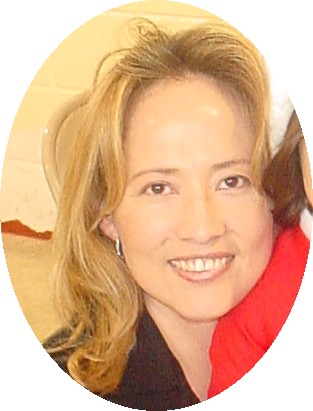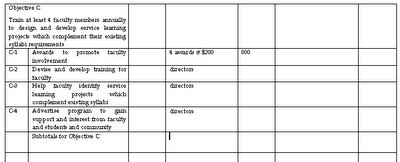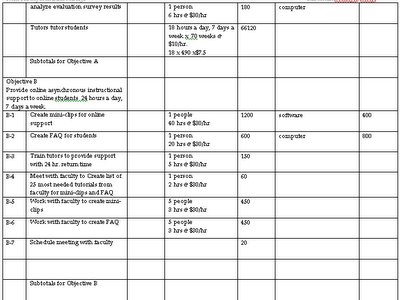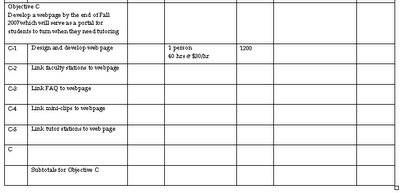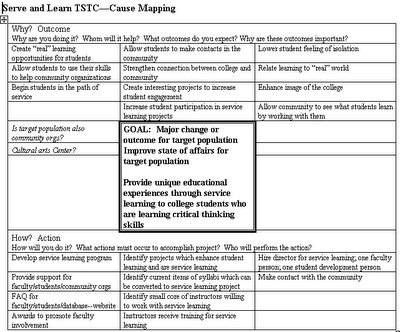Read Robert Samuels' "
Revealing Codes: Cognitive Mapping of Writing, Computers, and Grants at the Postmodern University" from Kairos. In what ways has your grant writing process been similar or different to what Samuels describes?
However, by trying to please this administrative audience, many grant writers end up undermining their own professional values and status. (Samuels)One issue which I have considered during grantwriting is how this project can affect my colleagues professionally. I think that in order to create and design a project which is going to be effective there needs to be faculty buy-in. As project designers, we need to, at times, straddle both sides of the fence. Rhetorically, we have to appeal to both sides or the project will not be a success. I have had to consider what will make the administration back my project, but at the same time, I know that I cannot use the same logic with the faculty nor with the students. No project deals with one single population and most of the time there are many more than two populations. We have learned that we must take two basic audiences into account: the organization and funding agency. Each has separate and distinct goals. It is the grantwriter's job to appeal to both audiences.
As Samuels argues, the grantwriter must also consider how the project will affect secondary populations, not only in terms of idealistic goals but also realistic ones. Most educators are genuinely interested in the learner, but we should not be so naive to consider that they will do something to jeopardize their own livelihood. I dare say that many educators first think about how a policy will affect them before they consider how beneficial (or not) it will be to students.
Project developers should be conscious of this and should consciously address the concerns of the secondary populations in their proposals. Eventually if a proposal is successful, it will become public information and secondary audiences will read the proposal and know that the project does not take them into consideration. The projects need to be designed so there is a win situation for as many populations as possible.
This is the end of my response to the question for this week, but I would like to address other comments in this article.
Since I began working with technology in the classroom one issue that is central to discussions, especially for those faculty members who do not use technology, is how technology undermines our values and status.
Samuels argues that the SPIDER
"project does nothing to help the status of writing faculty nor the status of composition as a field; in fact, it works to shift valuable funds away from the composition faculty" and that
"[a]s a field and a profession, one of our major concerns should be the protection of our faculty and the enhancements of our employment opportunities."
I agree that technology does not help the status of faculty, but that is only because the use of technology and implementation of technology in the classroom have not been institutionalized at most campuses to raise faculty status. The addition of use of technology as a "specialization" must be something which faculty demand. Then
"[i]nstructional grants that call for the improvement of undergraduate writing instruction" using technology would almost automatically
"[improve] composition employment status." Institutional change and progress on a broad topic such as employment should not be dictated by one specific grant project.
I completely disagree with Samuels that
"[a]nother problematic aspect of this new trend to get faculty to put all of their course material on the web is the question of who owns the material" and that
"this question of provable expertise is essential in protecting the jobs and status of composition faculty. It is thus a highly questionable project to ask faculty to place material on the web, which could lead to their own dis-qualification as expert teachers with needed specialized skills."
First of all, I have seen how technology has served to create jobs for faculty who otherwise would not have a position. I have yet to see a program in which faculty members lose jobs. Also, nationwide data shows that we currently do not have enough people in academia to meet the educational demands of the future. Technology can serve, not to replace jobs, but to fill the gap.
Most importantly, these comments, I think, reveal exactly how he thinks the status of faculty is derived which is ultimately the problem behind much of his argument. He uses the current system for deriving faculty status especially for those who are not tenure-track. But as individuals involved in academia, we must begin to think "outside the box" when it comes to the advancement of our own careers. In fact, no one is threatened by writing a book about teaching methodologies or teaching projects. In fact, this is usually a requirement for achieving tenure. Publishing on the web is another type of sharing of our ideas; the only difference is that no private company (i.e. publishing companies) are making money from all the academicians' endeavors. Publishing companies saw the threat and began years ago to head it off by offering their textbooks and anciallary materials online and pre-packaged to upload to a course managed in a learning management system. Perhaps just as books are purchased, online materials can be offered for a fee. Now instead of publishing companies reaping much of the benefit, the revenue can be kept on campus. This, it seems to me, would solve the issue of intellectual property and would have many turning to online publishing instead of viewing it as a threat.
Also, I have seen many faculty members who have experience using technology as an instructional tool and do not include it in their vita. In this instance, who is the one devaluing that experience? Many of us have to shift our perspective to see how technology can help us advance instead of how it threatens us. Teaching and publishing using technology must be included in faculty vitas and tenure or contract negotiations as valid qualifications and fields of expertise. Validation of this experience is something which faculty has control over and we should not wait for the stamp of approval to come from somewhere else.
